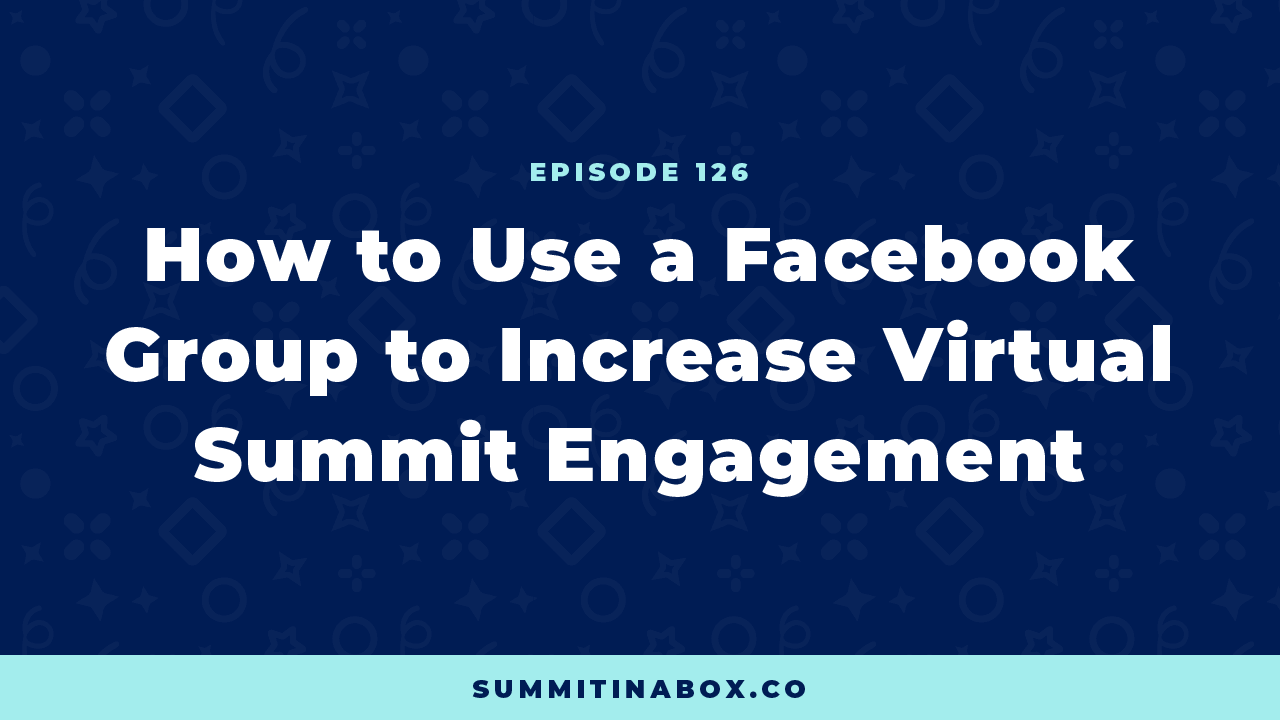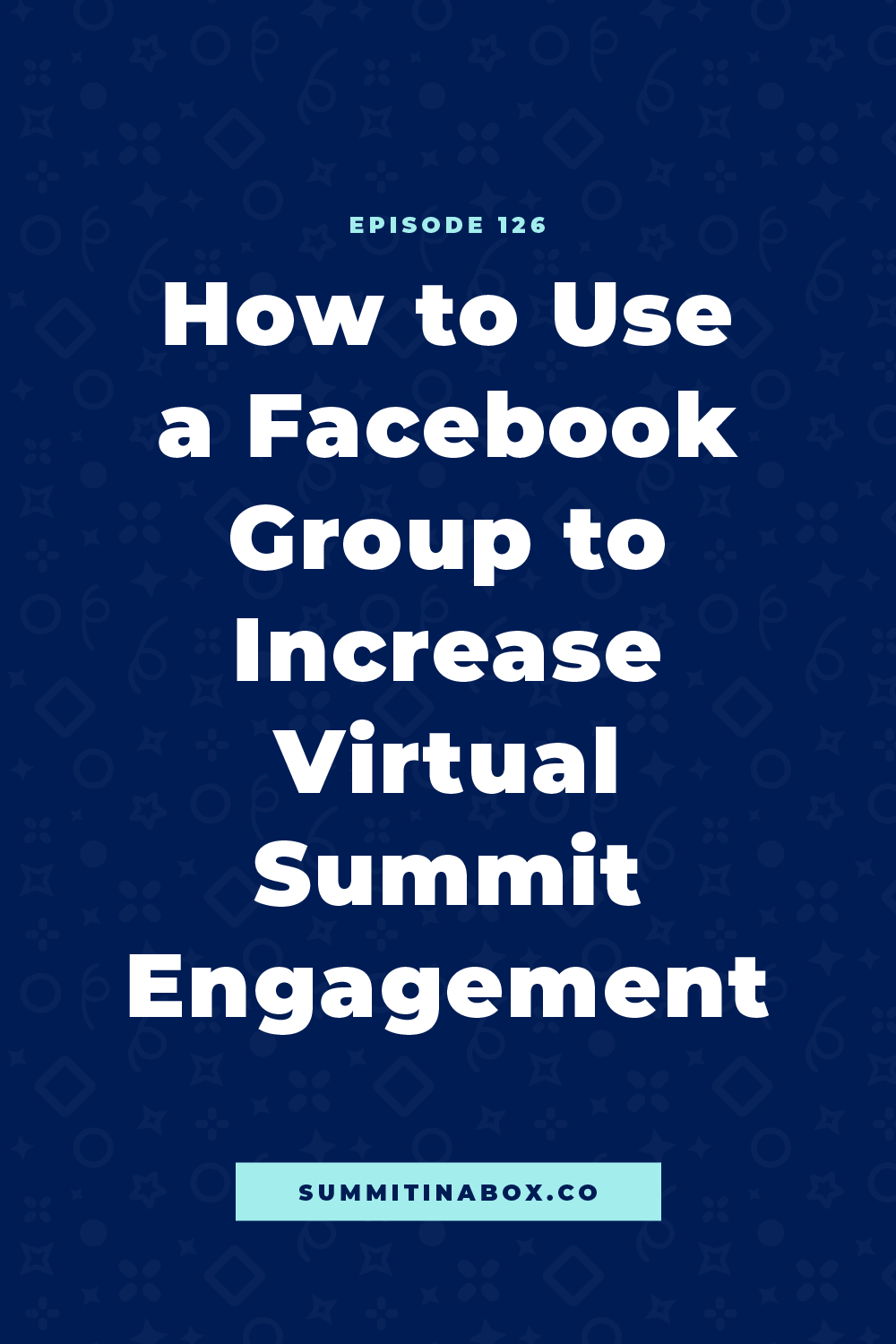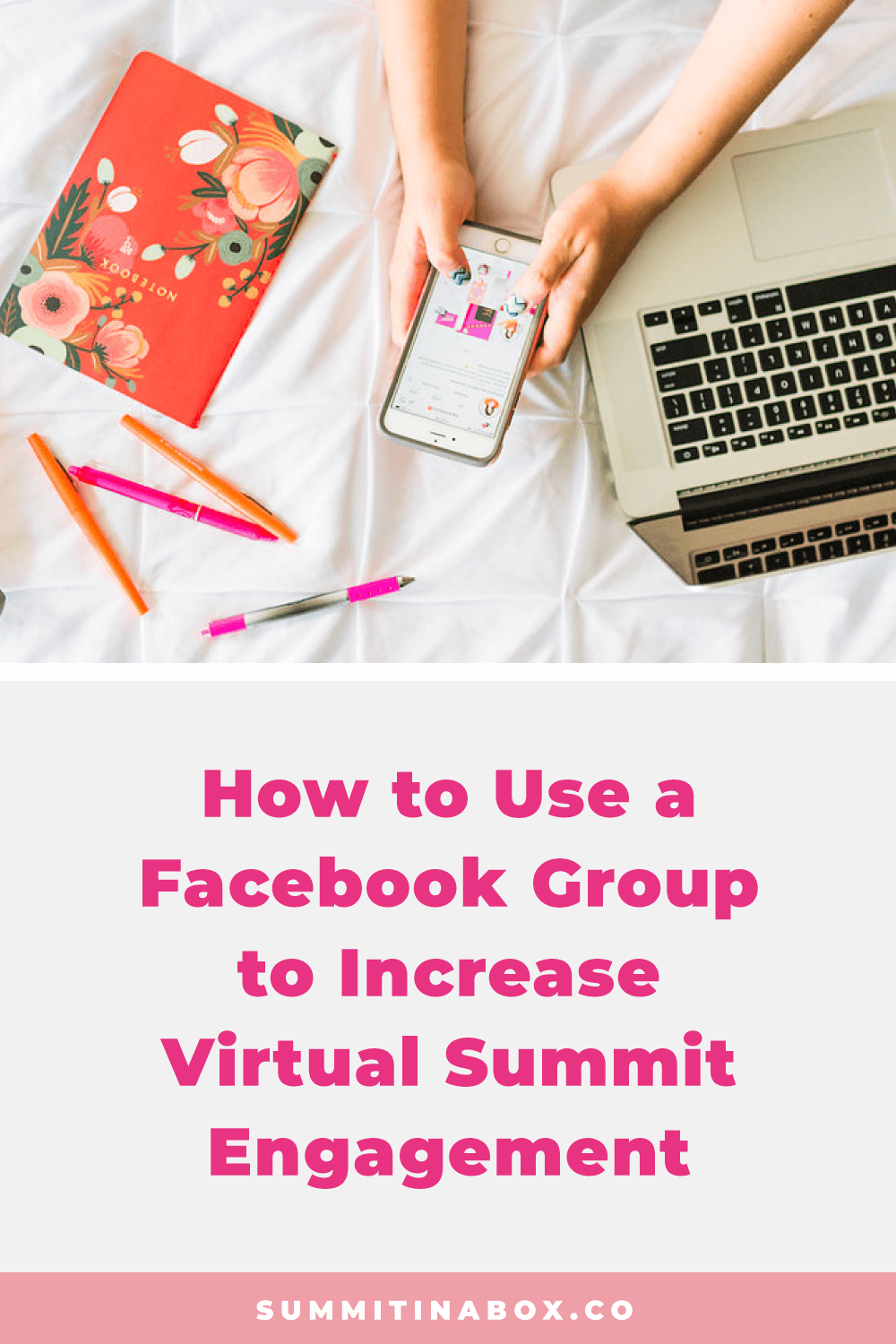How to Use a Facebook Group to Increase Virtual Summit Engagement


Engagement is a major key to hosting a profitable and community-building virtual summit. One of the best ways to boost engagement is with a Facebook group (or other community) just for the summit.
A summit community means having a place to come together, learn, implement, ask questions, and have a good time.
It's totally worth the “extra” work to have a community for your virtual summit, so let's cover:
- Why you should consider it
- Keys to a thriving community
- How to get attendees into the community
- Tips for managing your community
Why I lean toward a Facebook group
Really, when I say "Facebook group", this can be any type of community.
I simply lean toward using a Facebook group because many of your attendees are already on and actively using the platform. Even if they don’t use it every day, they have an account and know how it works.
This is preferred over a platform that’s going to be new to your attendees and comes with a learning curve.
If you try a new platform keep in mind that...
- Attendees may not try it because it’s new.
- If they do sign up, they won’t know how to use it.
- It means more customer support for you with all the questions that will come up.
- You may have less engagement overall because they're less likely to log in to a platform they don't already use regularly.
If you’re going to use something other than Facebook, make sure it’s easy for attendees to use. Record a walkthrough video to show them how to set up their account, show them around the platform, and explain what they’re supposed to do once they’re in.
Why your summit should have a community
The goal of a community is to get your attendees engaged, excited, and taking action together. Without a community aspect, all you can do is talk at your attendees via email. There's no way for them to engage back.
Without a community, it's not fun for you because you're not getting that engagement and feedback. It’s also not fun for attendees because all they can do is get talked at. They can't engage. It limits the results anyone can see through your event.
If you’ve been to summits that really make you feel connected and leave a lasting impression, I’d bet there’s a way for you to connect outside of having emails sent to you.
On the other hand, if you’ve been to summits that feel gross and spammy, I’d bet there wasn’t a community aspect.
Having a community helps:
- Attendees feel like a part of the event and take action on what they’re learning.
- Speakers have a place to connect with attendees and hear great feedback.
- You create an incredible experience, get better testimonials, and boost sales.
Keys to a thriving community
Crafting an engaging virtual summit with a thriving community keeps attendees interacting with your event. The more engaging your virtual summit is, the more you, your speakers, and your attendees will get out of it.
Here are a few things you can incorporate to boost your community's engagement.
Create a welcome video
First, create a short welcome video. You could do a Facebook Live or upload a pre-recorded video. Keep it short, sweet, and easy - 2 minutes is plenty!
If you're using a Facebook group, pin it as an announcement in the group so it's easy for new members to find.
Your video should include things like:
- A welcome to the new attendees
- A reminder of the summit’s goals
- The purpose of the group
- What they should do to get started
- Encouragement to introduce themselves
Daily prompts before the summit
Another way to get attendees engaged in your community is to have daily discussion prompts before the summit starts. I recommend you open the community as soon as registration opens for your summit, but you don’t want it to be completely silent until Day 1.
Use the daily discussion prompts to get people talking.
They can be fun prompts, such as:
- Post a picture of your pet!
- What's your favorite coffee?
They can also have market research mixed in, such as:
- What’s your biggest struggle related to _____?
- What presentation are you most excited about?
Bonus mini-trainings
Another way to encourage your community to thrive is by hosting bonus mini-trainings within the group. It’s especially important if you’re selling something later. Go live with mini-trainings that offer short, bite-sized, actionable pieces of information.
The mini-trainings help new-to-you attendees get to know you, your style, and see how much value you provide.
If you need ideas for mini-training topics, watch how attendees answer your questions when they join the community. For example, if you ask for their biggest struggle and notice a trend, it's a great topic for a mini-training!
Use Speakers and Friends to Get Conversation Going
Another helpful strategy, especially in that awkward beginning stage where no one wants to be the first one to comment, is to have friends or speakers join the group to help get the conversation going.
When new members see other people talking, they're more likely to join in.
New Member Welcome Posts
The next tip is to welcome your new members. This step is important because it invites attendees to join in the conversation.
This can sound like a lot of work, but it doesn't have to be. Facebook has a feature on the right sidebar to click one button and welcome all your new members.
For my most recent summit, we used a Chrome extension called HelloHostess. Whenever we let someone into the group, it commented on the welcome post and tagged them with 1 of 5 pre-written welcome messages. Attendees loved it! Every single person got their own welcome and responded with how excited they were. We got connections and conversations going just from the welcome post, nothing extra!
A reason to interact
Next, give your community members a reason to interact. The fact that it's fun or that they want to answer a question is cool, but if you can give them a bigger reason, that's even better. A great way to get attendees interacting is to use games and prizes.
For example, you can use a Bingo card with squares that can get crossed off when they take certain actions inside the group. Squares can include actions such as:
- Comment on a post.
- Give a speaker a shout-out.
- Share a big takeaway from a presentation.
Information and links during the summit
Another way to use your community is to provide the information your attendees will need to move through the summit. Each morning of the summit, post the information that attendees need for that day's sessions.
This cuts down on the amount of support-type questions in the group because the information is easily accessible.
Your time and attention
The last key to a thriving community for your summit is your time and attention. You can't expect people to join the group and talk to themselves. Your attention and encouragement are required if you want a community to thrive.
Putting the work into your community is worth it! It helps your attendees get better results, and increases the results you see as well. Plan to spend time in your community a couple of times per day, and respond to as many comments and posts as you can.
How to get attendees into the community
No matter what you do, not everyone is going to join your community. What’s the old saying? You can lead a horse to water, but you can’t make it drink? The same applies to your summit community. Even if only 20-30% of your attendees join, it’s still worth it!
The attendees that join your community are your most engaged people and are most likely to want to take the next step with you after the summit.
Here are a few ways to get attendees to join...
A Call-to-action
Joining the community should be a main call-to-action in many of your emails, starting from that initial confirmation email.
They're going to continue to be encouraged to join because:
- All of the daily emails during the summit will have a link and encouragement to join.
- The kickoff call happens in the community, so the only way to watch that is by joining.
A reason to join
You gave attendees a call-to-action, but that doesn’t mean they will always listen. Most attendees will also need a reason to join.
Some reasons or benefits of joining your community could be:
- Connect with other attendees - Some attendees need a place to connect with others, a place where they can feel supported and encouraged with like-minded summit attendees, speakers, and the host.
- Ask speakers questions - This is a great incentive for many attendees to join your summit community if your speakers are willing to be in there because they are able to directly ask their questions to the speakers.
- Games and prizes - Attendees can play games like Bingo and win prizes, but the games and prizes only take place within that summit community.
- Exclusive content - If you have exclusive content, like bonus mini-trainings, they can only be accessed within this community.
Tips for managing your community
I’m not going to pretend that having a community is a no-effort addition to your summit - it takes time and attention to grow an engaged group.
If you have the budget to outsource for someone to take care of scheduling posts, admitting members, and interacting for you, it is 100% worth it.
Here are some other tips to make it easier.
Admitting New Members
First, limit yourself to admitting new members once or twice per day. If you're going to have a summit with thousands of people, you could sit and constantly refresh the new member page and have new people to admit.
Use group join questions with one being that they have to agree to the group rules. Otherwise, you're going to increase the risk of ending up with a spammy group. If someone doesn't answer your questions or agree to the group rules, they don't get into the group.
Welcoming New Members
Second, when someone new joins the group, point them to your welcome video and let them know that you're happy that they joined.
You can use Facebook's welcome post feature and welcome new members anywhere from daily to weekly, depending on how many people you have. You can use something like HelloHostess to have new members automatically tagged in welcome posts or under your welcome video.
Engaging Members
Third, try to limit yourself to going into the group one to two times per day. But when you're in there, try to respond to every single comment. If someone took the time and had the courage to put themselves out there and say something, reward that.
Even if you have an assistant who can go in and do a lot of this for you, I encourage you personally to jump in and engage yourself as well. Otherwise, you're missing out on a whole other level that makes your summit worth running.
What are the next steps?
Having a community is extra work, but it's extra work that pays off in so many ways. There are a few starting steps you can take in order to build an engaging community for your virtual summit.
- Decide what platform is best for you.
- Make an engagement plan.
- Consider hiring help so it’s not all on you.
Resources
- Episode 53: How to Craft an Engaging Virtual Summit
- Episode 85: What to Outsource in Your Virtual Summit
- Summit Host Hangout Facebook group
Pin it for later!




